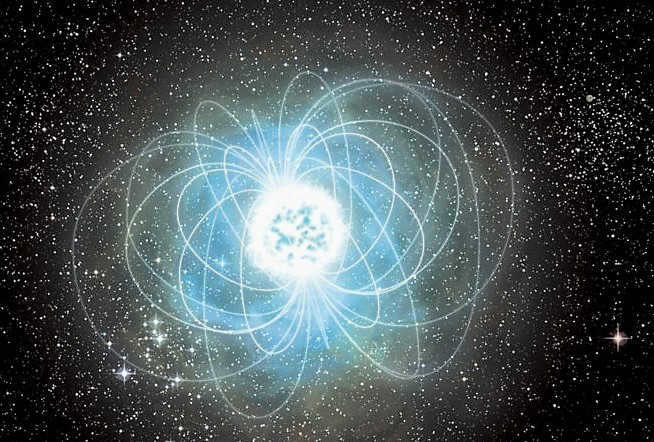Imagine a colossal entity with a mass equivalent to one and a half to two suns. Shrink it down to just a few kilometers in diameter, resulting in a cubic centimeter of material weighing hundreds of millions of tons. Introduce the most potent magnetic field known to exist in the cosmos. Surround it with an atmosphere of particles hurtling at nearly the speed of light. Naked Science elucidates the astonishing outcome of this extraordinary scenario.
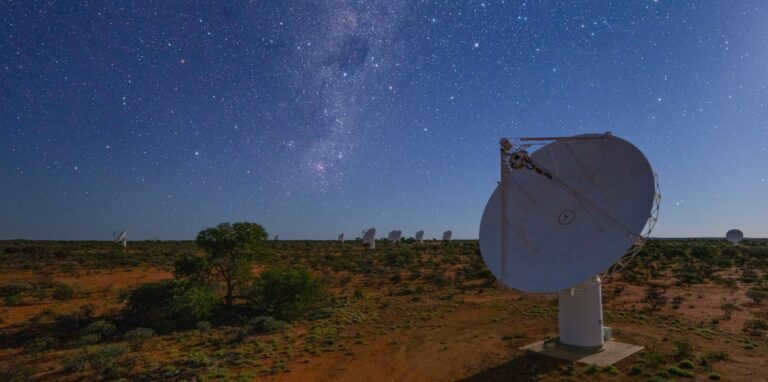
ASKAP/(c)CSIRO radio telescope antennas.
In recent times, astronomers have made an incredible discovery – they have found the most luminous pulsar outside of our galaxy, and one of the brightest pulsars overall. Interestingly, this particular object had been in plain sight for many years, yet its true nature remained unknown. Thankfully, an unconventional method of searching for pulsars led to the truth being uncovered.
Now, let’s delve into the world of pulsars and explore what makes them so interesting. These celestial objects are among the most extraordinary in the entire Universe, and they definitely deserve our attention! To briefly recap, a pulsar (specifically a radio pulsar) is a neutron star with an incredibly strong magnetic field. The mechanisms behind this, which we will discuss in more detail later on, transform it into a cosmic radio beacon that emits a highly regular signal.
Neutron stars serve as essential laboratories provided by nature itself for physicists. The density of matter in these stars, reaching hundreds of millions of tons per cubic centimeter, and the magnetic fields, measuring billions of tesla, are impossible for mankind to replicate. As a result, astronomical observations become the sole method to examine the behavior of matter under such extreme conditions.
However, this poses a challenge since neutron stars, except for a few exceptions, are virtually invisible to conventional optical telescopes. This is due to their incredibly small size, with a diameter measured in kilometers. To put it into perspective, the diameter of the Sun is nearly 1.4 million kilometers! Hence, the study of pulsars becomes one of the very few ways to investigate neutron stars.
Pulsars also have practical applications, such as navigation and timekeeping in everyday life.
Theorists believe that there may be tens or even hundreds of thousands of pulsars in our galaxy. Unfortunately, our current radio telescopes are not advanced enough to detect all of them. As of now, astronomers have only identified a few thousand pulsars. Discovering these objects in other galaxies is even more challenging, and only a small number have been found so far.
Recently, a newly found pulsar called PSR J0523-7125 was located in the Large Magellanic Cloud, a satellite galaxy of the Milky Way. In terms of brightness, it surpasses the previous “record holder” from this galaxy by more than double.
Interestingly, this bright object had been observed for a long time, but no one suspected it to be a pulsar. It was initially mistaken for a distant background galaxy. It wasn’t until astronomers at the Australian radio telescope ASKAP used an unconventional method of pulsar detection that its true nature was revealed.
Instead of utilizing the most apparent characteristic of pulsars – their periodicity – they chose to search for radio sources with strong circular polarization. Although this is a feature of pulsars, it is rarely employed to locate them.
Upon detecting PSR J0523-7125, the astronomers proceeded to observe it using South Africa’s MeerKAT telescope. This is how they stumbled upon the sought-after periodic pulses, which turned out to be remarkably long. In the majority of pulsars, the pulse only lasts 1-5% of the period (the time between pulses). However, in the case of PSR J0523-7125, this fraction amounts to a staggering 35%. This discrepancy may explain why conventional methods failed to identify this object as a pulsar.
The authors are optimistic that their approach will enable them to discover numerous other peculiar pulsars, including those situated in neighboring galaxies.
Let us now introduce you to these incredible objects.
The rotation parameters of the pulsar have been measured by scientists with a level of accuracy that is a million times greater than previous analyses.
Unidentified extraterrestrial beings
The story behind the discovery of pulsars is quite fascinating. It was a rare occasion when scientists were genuinely concerned about whether they had come across a communication from beings of higher intelligence.
Radio telescopes, which receive radio waves from the depths of the Universe, function in a similar manner to household radios. You could even replace the recording computer with a speaker and attempt to listen to the “music of the spheres”. However, in this case, it would only result in meaningless crackling and hissing. But that is not the case with pulsars.
In July 1967, Jocelyn Bell, a graduate student at Cambridge University, analyzed data from a radio telescope. She observed a recurring radio signal that occurred every 1.337 seconds. Rather than being a random noise, it was a precise and consistent ticking. It felt as if a colossal metronome in the cosmos was counting down the beats, with a level of accuracy comparable to an atomic clock. To say it appeared peculiar would be an understatement.
Initially, Anthony Hewish, Bell’s supervisor, suspected the signals to be interference from some sort of machinery. They resembled the sounds emitted by a beacon or locator. However, the graduate student demonstrated that the enigmatic ticking originated in space. Furthermore, its regularity seemed deliberately artificial. The discoverers dubbed the mysterious entity LGM-1, an abbreviation for “little green mans.”
Scientists have achieved a groundbreaking level of precision in their observations of the pulsar, being able to distinguish details that are separated by a mere 20 kilometers.
Contact has been canceled
Anthropologist Stanislav Drobyshevsky once famously stated: “One of the fundamental principles of any scientific pursuit is to be incredibly meticulous.” It seems that whenever someone comes up with a brilliant hypothesis, their colleagues will immediately come up with a list of 127 reasons why it’s too early to consider it as a proven fact. As frustrating as it may be, this is the very essence of science, allowing it to search for the truth without becoming entangled in a web of fantasies.
Despite the allure of the extraterrestrial explanation, astronomers have been diligently searching for a natural cause behind the peculiar characteristics of pulsars. It is evident that the periodic radio signals emitted by these celestial bodies are a result of some periodic process occurring in space, but what exactly is that process?
Scarcely any amorphous cloud of gas is capable of operating with the precision of an atomic clock. This strict regularity implies that we are discussing the movement of a solid object. And what type of movement would that entail? Spinning on its axis? Orbiting? Pulsating?
The duration of this movement was also perplexing – on the order of one second. Whatever the spatial beacon was, it was exceedingly small. If the Earth, with a radius of 6400 kilometers, completed one revolution on its axis in a second, the velocity of the point on the equator would surpass 40 thousand kilometers per second, reaching 13% of the speed of light!
However, it didn’t take long for scientists to unravel the mysteries surrounding pulsars. They already had all the pieces of the puzzle in their hands. In 1934, just two years after the discovery of the neutron, Walter Baade and Fritz Zwicky proposed that neutron stars are formed during supernova explosions. And just before the discovery of pulsars, Nikolai Semyonovich Kardashev and Franco Pacini demonstrated that a neutron star must rotate rapidly and possess a strong magnetic field. Drawing on these ideas, Thomas Gold deciphered the true nature of pulsars shortly after their discovery, even though alternative theories were still being considered for a while.
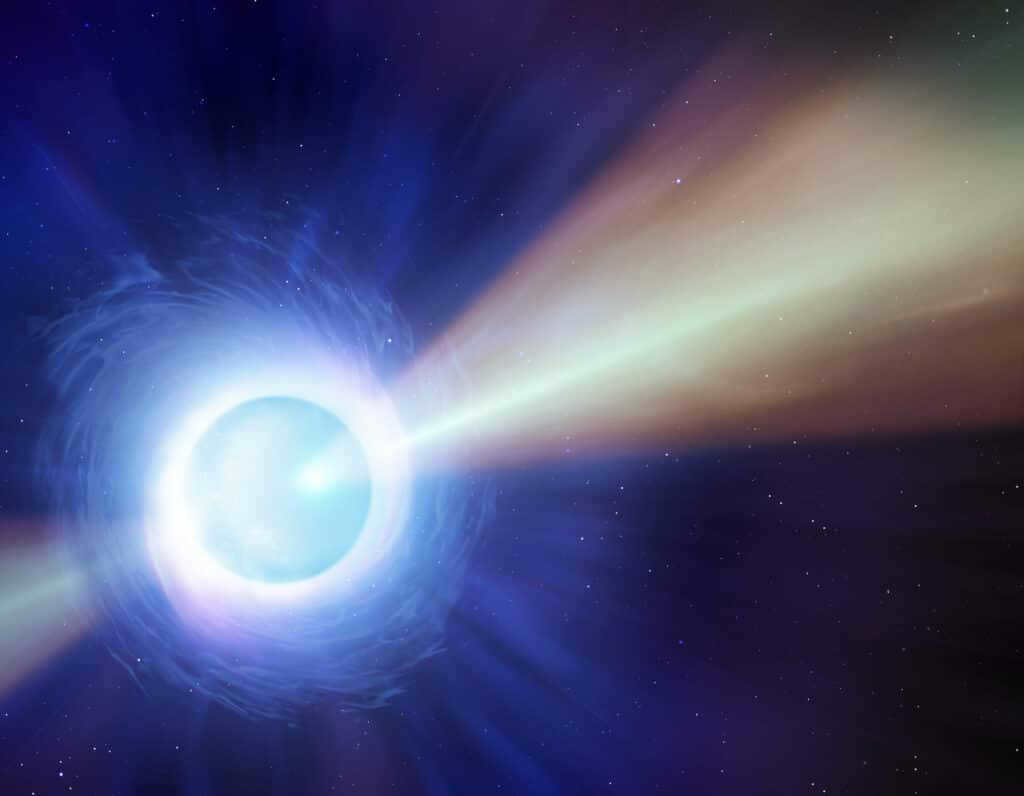
A Memorable Trail
During that period, theorists were the only ones familiar with neutron stars, while observers were not. The discovery of pulsars served as the first confirmation that neutron stars were not just theoretical constructs, but actually existed in the real world. It was this achievement that led to Huish receiving the 1974 Nobel Prize in Physics, although Bell somehow did not receive the same recognition.
Neutron stars can be considered as the celestial afterlife of certain luminaries. Let’s delve into this topic further.
If it weren’t for the pressure that prevents compression, any star would collapse into a tiny mass due to its own gravitational force. Surprisingly, it is not matter, but radiation that plays a crucial role in exerting this pressure. The star is essentially saved from its demise by the power of light – its own light.
Throughout its lifespan, the star gradually loses mass due to the stellar wind and radiation. However, the star remains significantly massive until its final moments. Once the thermonuclear fuel is depleted, the star is left to contend with the force of gravity alone, leading to a disastrous outcome.
In the case of a star that had a birth mass exceeding ten times that of the Sun, its demise is accompanied by a breathtaking spectacle. The outer layers of the star, no longer supported by radiation, rapidly collapse onto the dense core and rebound like a bouncing ball. The energy released from this collision is so immense that the expanding shell of the star ignites and glows like an entire galaxy. This extraordinary event is known as a supernova explosion.
Meanwhile, the tremendous force of gravity is rapidly compressing the core of the star. The immense pressure is so intense that even the atoms themselves are unable to withstand it. Deep within the celestial body, electrons and protons merge together, forming a solid mass of neutrons that is even denser than the atomic nucleus. It is at this point that the crushing pressure finally halts the compression.
If the core of a star is more than 2.7 times the mass of the Sun, even the pressure exerted by neutron matter is insufficient. In such cases, the core of the deceased star transforms into a black hole. However, that is a separate tale, and our focus here is on neutron stars.
Now, let us recall the principle of momentum conservation. This principle leads us to a simple fact: when a rotating body is compressed, it begins to spin faster. A figure skater who pulls their arms in close to their body while executing a tulup jump can certainly grasp this concept.
In the autobiography of a celestial body, one might envision a chapter titled “The Transformation into a Neutron”. “It was a challenging period for me. A time of significant loss (oh yes, such a massive loss! – Naked Science). I had to become even more resilient and increase my rotation speed. And now, I am no longer referred to as sunshine.”
The mention of rigidity is not without purpose. Neutron stars are arguably the most durable and robust entities in the entire universe. This is why these celestial bodies are able to withstand the immense centrifugal force caused by their rapid rotation without collapsing.
In the case of a massive giant star with a mass of 1.5-2.7 times that of the sun, it is extremely difficult to alter its rotational speed, whether to slow it down or speed it up. This is due to the immense inertia of the star, resulting in an almost perfectly constant rotation rate. Hence, a pulsar can be considered as an exceptionally stable clock. Technically speaking, it does experience a gradual slowdown, but the deceleration is incredibly gradual, amounting to less than a second per 100 million years. This deceleration occurs as the pulsar’s rotational energy is gradually depleted through radiation emission.
The excess gamma rays emanating from the core of our galaxy, the Milky Way, have finally been accounted for. The most plausible explanation for their source is an unaccounted population of millisecond pulsars, which are formed through a “non-standard” process.
In the 1960s, scientists at Cambridge University were conducting research on different types of cosmic radiation. During their studies, they stumbled upon a unique pulsation that occurred every 0.3 seconds and had a frequency of 81.5 MHz.
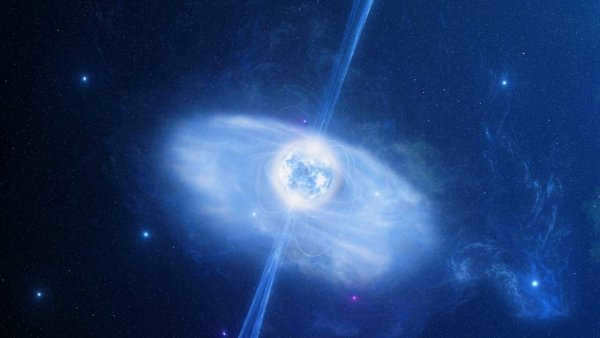
When the radiation appeared in an “organized” and periodic manner, some scientists initially mistook it for messages from extraterrestrial civilizations. This led to the involvement of specialists in coding to decipher the signals.
However, attempts to read the “letters from space” were unsuccessful. Eventually, three more sources of similar flickering were discovered and named pulsars. Anthony Hewish, the leader of the British discovery team, was awarded the Nobel Prize in Physics for this groundbreaking contribution to science.
What are pulsars?
Initially, the true nature of pulsars was not immediately comprehended. Due to the peculiarities of their radiation, it was initially hypothesized that they possessed a structure akin to atomic nuclei, with a similar density. However, subsequent findings revealed that these celestial objects bear resemblance to colossal planets.
Through further investigation, scientists reached the conclusion that pulsars are actually neutron stars that form as a result of a supernova explosion and emit radio waves. The consistent pulsations observed are attributed to the stable rotation of these neutron stars.
Categories of neutron stars
Neutron stars can be classified into two groups based on their rotation periods: those with short rotation periods and those with long rotation periods. Interestingly, the oldest neutron stars have rotation periods in the millisecond range, while the youngest ones rotate slower. Notably, the “oldest” pulsars possess weaker magnetic fields.
Another type of neutron star is the X-ray pulsar, which emits X-rays. These pulsars exhibit distinct characteristics.
Currently, scientists have identified over 1,300 pulsars. Approximately 90% of these pulsars have rotation periods ranging from 0.1 to 1 second, or even shorter. The pulsar located in the Foxy constellation holds the record for the shortest known rotation period, with a period of 0.00155 seconds.
The Most Brilliant
According to scientists, the pulsar in the Crab Nebula “ignited” in 1054. Historians from Arabian countries and China documented an extraordinary celestial event. The supernova explosion was so incredibly powerful that it could be seen by people on Earth even during the daytime.
Several centuries later, astronomers found a new nebula at the location of the explosion. William Parsons, the discoverer of the celestial object, thought that the nebula resembled a crab, hence its name. The renowned pulsar that scientists observed in 1968 in the Crab Nebula was given the name PSR B0531+21.
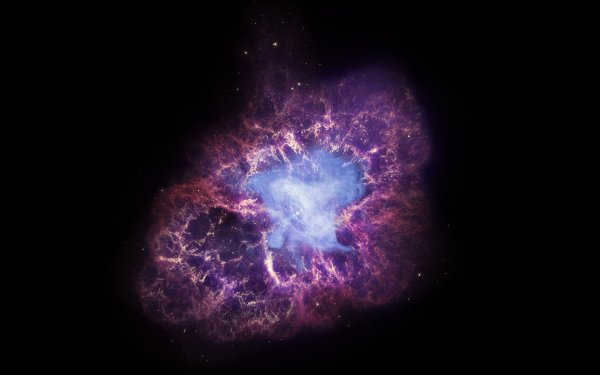
Unanswered Enigmas
Not all the advantages of this celestial body from the Crab Nebula lie in its extraordinary speed (30 revolutions per second) and remarkable luminosity. PSR B0531+21 also emits highly energetic rays in an exceedingly unusual range, exceeding 100 billion volts. To put this into perspective, this is millions of times greater than the pulses produced by medical equipment. However, the radiation levels are also significantly higher than what is predicted by gamma ray theory.
At present, scientists are at a loss, unable to provide an explanation for this phenomenon. The lifespan of neutron stars, which is significantly longer than that of their “mother” nebulae, cannot be accounted for. Additionally, these stars emit incredibly powerful radio waves. There are numerous other questions that scientists hope to address in the near future.


Thanks to advancements in technology during the mid-20th century, scientists have been able to uncover numerous previously unknown celestial objects. Objects that emit periodic pulses into space, known as pulsars, have been particularly intriguing. These pulsars emit radiation across the optical, radio wave, and X-ray spectra.
In June 1967, Jocelyn Bell, a graduate student of E. Hewish, made the discovery. Interestingly, the findings were initially classified, with the periodic signals being mistakenly attributed to extraterrestrial civilizations. However, it was eventually realized that pulsars are actually neutron stars that emit focused streams of radiation. The periodic signals we observe are a result of the star’s rotation.
It is referred to as a pulsar pulse by scientists. Pulsars come into existence when a massive star undergoes a shrinkage (a process known as a supernova explosion) to a size of just a few tens of kilometers. This shrinkage greatly increases the density of the star by an unimaginable factor, with a teaspoonful of such material weighing billions of tons. As a result, the star’s rotation period around its axis decreases to seconds and even milliseconds. It is from this characteristic that pulsars derive their names: seconds and milliseconds.
The speediest ones emit a hundred pulses per second at their maximum rate. Their velocity can be influenced by the satellites they draw in, resulting in acceleration. These celestial objects are incredibly peculiar, with seismic-like phenomena taking place on their exterior. As previously stated, the surface of pulsars resembles the Earth’s crust due to matter compression, albeit hundreds or even thousands of times denser. If, for any reason, the pulsar decelerates its rotation, outer crustal activities initiate that have the potential to fracture it.
By reading this material further:
Pulsar flashes aid scientists in intricate computations
A group of astrophysicists subjected the pulsar bursts to an elaborate and thorough examination, enabling them to identify an uncommon gamma-ray emission. The acquired data proved instrumental in the characterization of the binary system by the scientific team at the Einstein Institute. After conducting sophisticated investigations of the system, researchers have uncovered several anomalies that exert a profound influence on the orbital period. As stated by the authors.
A groundbreaking find: an incredibly luminous pulsar has been unearthed
In a remarkable breakthrough, scientists have stumbled upon a pulsating celestial body that releases an astonishing amount of energy, surpassing the Sun’s output by a staggering ten million times. This remarkable discovery marks the brightest pulsar ever documented. Being a variation of a neutron star, it emits exceptionally intense energy beams. Armed with this newfound knowledge about the existence of ultra-bright pulsars, astronomers are now eager to uncover more similar entities, as the probability of detecting them is considerably high.
The NGC 3521 galaxy has been captured in unique images by the Hubble telescope

The NGC3521 galactic space has been captured in stunning new images by American astronauts using the Hubble telescope. These photos have revealed the presence of intriguing space entities that have left scientists puzzled. The images were taken within the vast expanse of the Milky Way galaxy. Further images of the galaxy formation are now being planned in order to closely examine these enigmatic objects.

A pulsar is a specific type of neutron star that remains after a massive star undergoes a supernova explosion. Pulsars are distinct from regular neutron stars due to their ability to emit intense radiation in the form of radio waves, optical light, X-rays, and even gamma rays. Additionally, pulsars rotate at incredibly high speeds. Scientists are able to identify pulsars by observing the regular radio pulses they emit at consistent intervals.
Pulsar formation
The process of pulsar formation is very similar to the creation of a neutron star. When a massive star with a mass between 4 and 8 times that of our Sun reaches the end of its life cycle, it undergoes a supernova explosion. This explosion causes the outer layers of the star to be expelled into space, while the inner core is compressed by its own gravity.
The intense gravitational pressure within the core is so powerful that it overwhelms the forces that hold atoms together. As a result, electrons and protons within the core merge to form neutrons. The gravitational pull on the surface of a neutron star is approximately 2×10^11 times stronger than the gravitational force on Earth.
In cases where the original star is even more massive, the supernova explosion can cause the core to collapse into a black hole. However, if the star is less massive, like our Sun, it will instead expel its outer layers and gradually cool down, eventually becoming a white dwarf.
However, for stars with a mass between 1.4 and 3.2 times that of the Sun, they still have the potential to go supernova, but lack the necessary mass to form a black hole. Instead, these intermediate-mass stars end their lives as neutron stars, and some of them can transform into pulsars or magnetars. Throughout the collapse of these stars, they retain their angular momentum.
Yet, as they shrink in size, their rotational velocity increases significantly, spinning multiple times per second. This incredibly small and dense object emits a strong burst of radiation along its magnetic field lines, although this beam of radiation does not necessarily align with its axis of rotation. In essence, pulsars are essentially rotating neutron stars.
The Origin of Pulsars: A Brief Historical Overview
In the year 1967, a groundbreaking discovery was made that left the scientific community astonished. It involved the detection of pulsars, celestial objects emitting periodic radio signals. These peculiar radio emissions emanated from a fixed location in the sky, with a distinct peak occurring every 1.33 seconds. The regularity of these emissions led some astronomers to entertain the possibility that they could signify interstellar communication with an advanced extraterrestrial civilization.
Despite astronomers’ certainty that it originated naturally, they gave it the moniker LGM-1 (an abbreviation for Little Green Men). Further findings aided astronomers in uncovering the genuine essence of these peculiar entities. Scientists presumed them to be swiftly spinning neutron stars. This supposition was substantiated by the revelation of a pulsar with an exceedingly brief rotational period (33 milliseconds) within the Crab Nebula. To date, over 2000 pulsars have been unearthed, with the speediest one emitting 716 pulses per second.
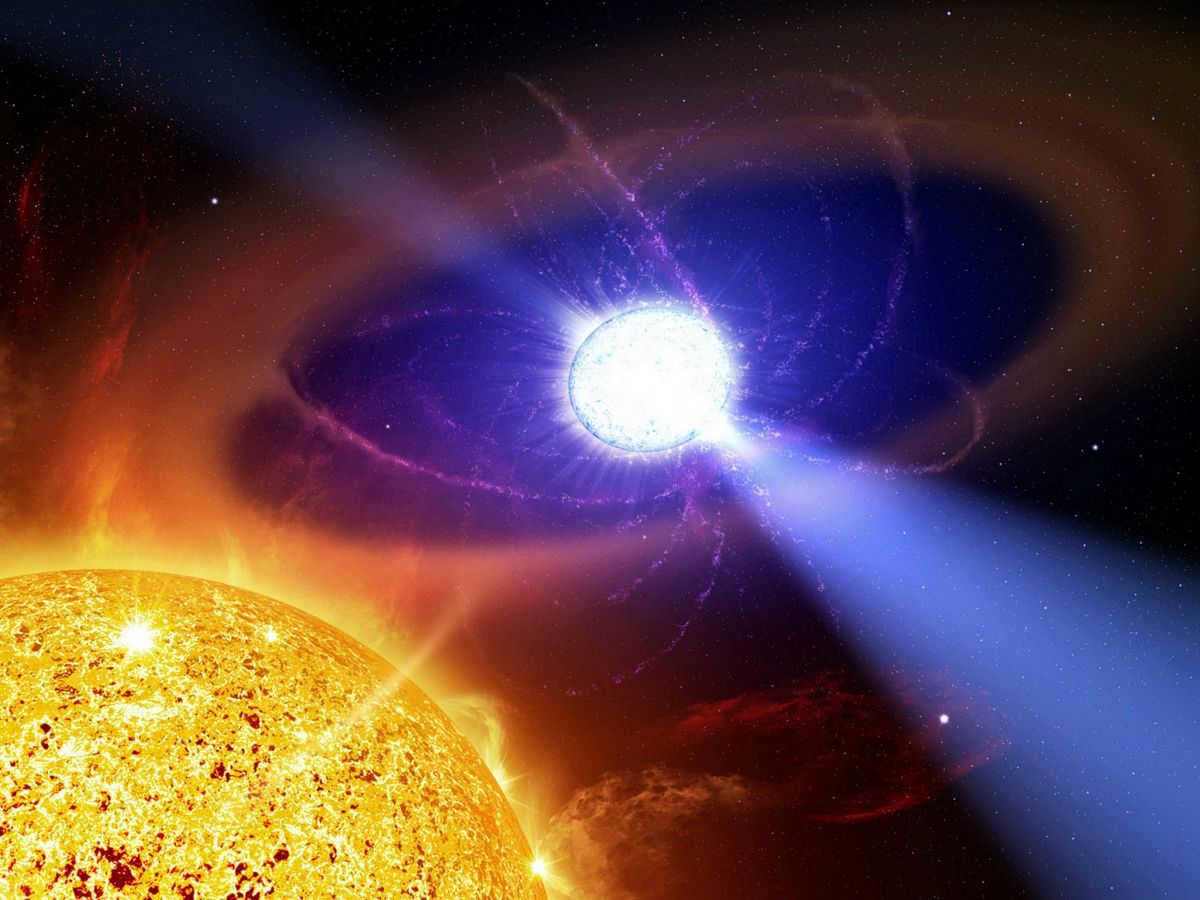
The Black Widow pulsar is consuming its stellar partner.
Pulsars were subsequently discovered in binary systems, validating Einstein’s general theory of relativity. And in 1982, a pulsar with a rotation period of only 1.6 microseconds was detected. In reality, the initial exoplanets ever identified were observed circling a pulsar, naturally, this would not be an ideal habitat.
Engaging Trivia
When a pulsar is born, it possesses immense energy and whirls at an incredibly fast pace. However, as it emits electromagnetic energy, it gradually decelerates. Within a span of 10-100 million years, it slows down to the extent where its beams fade away and the pulsar falls silent.
While active, these celestial objects spin with remarkable regularity, making them ideal as timekeepers for astronomers. In fact, certain types of pulsars are believed to rival atomic clocks in their precision and accuracy in keeping time.
Pulsars also serve as valuable tools in the search for gravitational waves, the exploration of the interstellar medium, and even the detection of exoplanets in orbit. As a matter of fact, the first exoplanets were discovered around a pulsar in 1992, when astronomers Alexander Wolschan and Dale Fraile announced the astounding revelation of a multi-planet system surrounding PSR B1257+12, a millisecond pulsar that was already known to harbor two exoplanets.
There is even a suggestion that spaceships could utilize pulsars as guiding beacons for maneuvering within the solar system. The NASAVoyager 1 spacecraft possesses detailed maps indicating the positions of 14 pulsars in our vicinity, allowing for precise navigation in relation to the Sun. In the event that extraterrestrial beings sought to locate our home planet, they would struggle to find a more accurate and effective map.

Pulsars are a result of supernova flares, and these flares come in different types. The discovery of the first pulsar dates back to 1967 when Anthony Hewish made the breakthrough.
The structure and composition of pulsars are primarily understood through theoretical models and mathematical calculations. They are predominantly composed of neutrons, which form the core with an incredibly high density surpassing that of a nucleus by several times.
All the radiation emitted by pulsars is concentrated within their compact atmosphere. Surrounding this cluster is a dense crust made up of tightly packed electrons and ions.

Pulsars generate nuclear matter and plasma due to their strong magnetic field. This happens when they rotate at a speed of approximately 1000 revolutions per second. In contrast, the magnetic field of the Earth is billions of times weaker.
A pulsar is essentially a spinning neutron star. Due to its rapid rotation, it possesses a compact and dense structure.
Interestingly, pulsars can exhibit varying rotation periods. This led scientists to discover millisecond pulsars, which are among the oldest known objects with a weak magnetic field. These objects typically have rotation periods ranging from one to ten milliseconds.
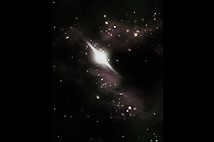
Their theoretical origins are believed to be pulsars that had a short rotation period, which gradually increased over time. This is why they are often referred to as spin-ups.
X-ray pulsars
X-ray pulsars are a specific kind of neutron stars that emit X-ray radiation. These cosmic sources of radiation are known for their variable pulse emissions.
Interestingly, X-ray pulsars are found in close binary systems, where a normal star and a neutron star orbit each other.
Radio pulsars
Radio pulsars are a diverse group of cosmic objects that emit periodic pulses. These pulsating sources can be detected using radio telescopes, among other methods.
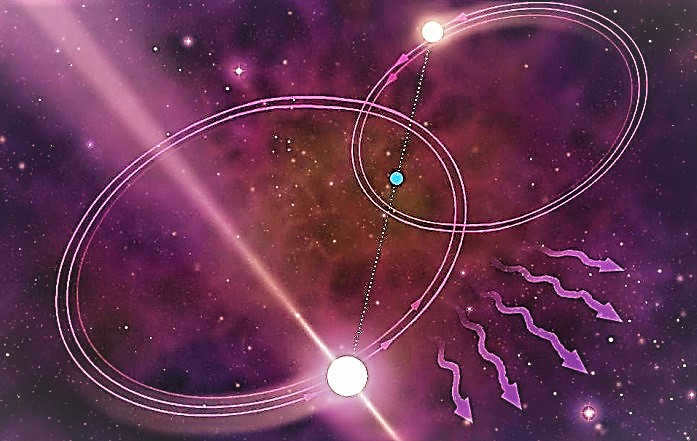
Optical pulsars
Additionally, it has been determined that there exist optical pulsars. These pulsars emit radiation that can be observed within the optical range of the electromagnetic spectrum.
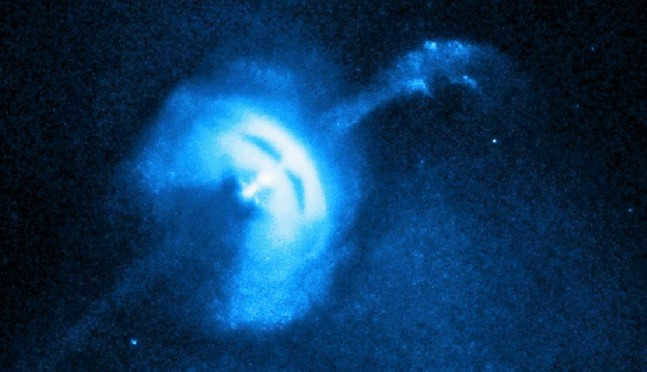
Gamma-ray pulsars
These celestial objects are, in fact, the most potent emitters of gamma rays in the cosmos. Gamma rays are a form of electromagnetic radiation characterized by their short wavelength and high energy, consisting of a stream of high-energy photons.
Magnetars
Scientists have identified the existence of neutron stars in space that possess an immensely strong magnetic field, known as magnetars. These unique objects are formed when a star with sufficient mass undergoes a supernova explosion.
Initially, astronomers hypothesized the presence of magnetars, but it wasn’t until 1998 that they obtained concrete evidence to support their theories. They successfully detected a powerful burst of X-ray and gamma-ray emissions from one of these objects located in the constellation of Eagle.
Currently, magnetars remain a relatively unexplored phenomenon, making them intriguing and enigmatic entities within the vast expanse of the Universe.
